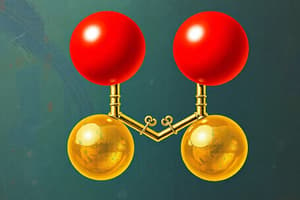Podcast
Questions and Answers
Which of the following is true about achiral molecules?
Which of the following is true about achiral molecules?
- They can have an inversion center. (correct)
- They must have a plane of symmetry.
- They must contain a chirality center.
- They always exhibit optical activity.
What is the failsafe method mentioned for identifying achiral molecules?
What is the failsafe method mentioned for identifying achiral molecules?
- Applying absolute configuration rules
- Generating the mirror image and trying to superimpose it on the original (correct)
- Looking for a center of symmetry
- Identifying chirality centers
In Cahn-Ingold-Prelog notation, what does 'R' signify?
In Cahn-Ingold-Prelog notation, what does 'R' signify?
- Clockwise rotation (correct)
- Plane of symmetry
- Inversion center
- Chirality center
When determining absolute configuration using Cahn-Ingold-Prelog rules, which group should you draw an arrow from if the lowest priority group is on a hatched wedge?
When determining absolute configuration using Cahn-Ingold-Prelog rules, which group should you draw an arrow from if the lowest priority group is on a hatched wedge?
What is the significance of a solid wedge when determining absolute configuration?
What is the significance of a solid wedge when determining absolute configuration?
Which method should be employed to determine if a molecule is chiral?
Which method should be employed to determine if a molecule is chiral?
'S' in Cahn-Ingold-Prelog notation represents which type of rotation?
'S' in Cahn-Ingold-Prelog notation represents which type of rotation?
'R/S' notation is primarily concerned with assigning what to enantiomers?
'R/S' notation is primarily concerned with assigning what to enantiomers?
'R' and 'S' notations are used mainly in the context of what molecular feature?
'R' and 'S' notations are used mainly in the context of what molecular feature?
Flashcards are hidden until you start studying
Study Notes
Levels of Organic Structure
- Organic compounds can be described using different levels of structure: composition, constitution, configuration, and conformation
Chirality
- A chiral molecule is not identical to its mirror image (is not superimposable on its mirror image in three dimensions)
- A molecule that is superimposable on its mirror image is called achiral
Chirality Centers
- A carbon bonded to four different groups (w, x, y, and z) is called a chirality center
- A chirality center can be used to identify a compound as chiral
- Molecules with more than one chirality center may be achiral
Enantiomers
- Enantiomers are mirror images that are not identical
- Enantiomers exhibit configurational isomerism
- A molecule cannot be an enantiomer in isolation; it requires a mirror image molecule
Identifying Chirality Centers
- To identify a chirality center, check if the carbon is bonded to four different groups
- Note that any differences in ring groups make them distinct for the purposes of identifying chirality centers
Studying That Suits You
Use AI to generate personalized quizzes and flashcards to suit your learning preferences.




